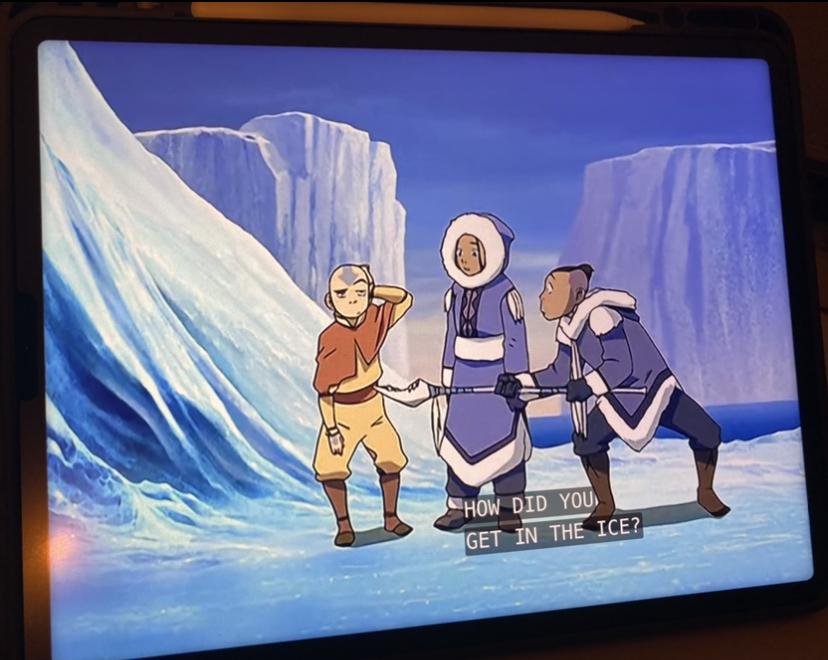The perfection of Avatar: The Last Airbender
Is it still worth a watch in 2022?
Episode 1 of Avatar, titled: “The Boy in the Iceberg”
“Water. Earth. Fire. Air. Long ago, the four nations lived together in harmony.”
If you were a child in the early to mid-2000s, these words probably sound familiar. They are part of the opening monologue of the popular Nickelodeon show “Avatar: The Last Airbender,” which follows the 12-year-old Avatar, Aang, on his quest to master the elements and end a 100 year-long war. Despite tackling mature themes for a children’s show, it quickly became a hit, spanning 3 seasons which aired from February 2005 to July 2008. At its Premiere, The Last Airbender was the highest-rated animated children’s show for its demographic, with an average of 1.1 million viewers tuning in for each new episode, according to its Wikipedia page.
It makes sense that this show gained popularity at the time of its release, but it has also made an apparent comeback in recent years, specifically during the international lockdown. While this most likely has something to do with nostalgia, what else makes this show so treasured among those who have watched it? Why has it been able to stand the test of time, and remain such a beloved television series?
The show takes place in a world divided into 4 groups, based on the four traditional elements, The Water Tribe(s), The Earth Kingdom, The Fire Nation, and The Air Nomads. Each of these groups consists of “benders” and “non-benders,” the former of which can “bend,” or control their respective element. The Avatar, however, who has been reincarnated for thousands of years, can master all four elements and is tasked with bringing balance, and harmony to the world.
In its pilot, we are introduced to this world, which has been ravaged by a war started by The Fire Nation, for the past 100 years. The young hero, Aang, is discovered by our deuteragonists, siblings Katara and Sokka, frozen in ice, where he has been trapped for 100 years. Skeptical of his origins, they take him back to their village in the Southern Water Tribe. They realize that he is an air-bender, the last of his kind. One hundred years prior, soon after Aang’s disappearance, all of the air nomads were wiped out at the beginning of the war.
His whereabouts are quickly discovered by the series’ resident anti-hero, Zuko, the young prince of the Fire Nation, exiled and on a seemingly impossible quest to capture the Avatar; the only way to restore his honor and be welcomed back home. After Zuko’s first of many failed attempts to catch him, Aang, Katara, and Sokka set off on their journey.
Throughout the course of the show, the characters all experience their own separate character arcs, overcoming their personal hardships and problems. Because of its format, we have plenty of time to get to know them and watch them grow, fail, and redeem themselves. It’s refreshing to see character arcs that are actually well thought out.
For example, Zuko goes through a complicated and realistic redemption arc. On his path, he meets a few obstacles and consistently makes wrong choices due to outside pressures, but ultimately makes the right decision. He goes from following his EXTERNAL want to be validated and accepted to his INTERNAL need to be himself and fulfill his destiny. This is a perfect parallel to Aang, who goes from trusting his INTERNAL want to just be a kid, to his EXTERNAL need to be a hero.
In fact, their parallels don’t end there. Their dichotomy and their yin and yang positions are mirrored in the series’ theme music. Aang’s theme is the opening soundtrack, while Zuko’s theme is the closing soundtrack, along with some other little hints here and there. Pretty cool, right?
Aside from Aang and Zuko, the other characters go through their own development arcs. Toph, a 12-year-old blind earth-bender who teaches Aang earth bending, grows from her self-reliant, distrusting nature, into learning to accept help from her friends. Sokka lets go of his initial misogynistic beliefs and “no fun attitude,” and learns to liven up. In the first episode he says, “You can’t fight fire-benders with fun,” and by the end, he is doing just that. Finally, Katara faces her grief and suffering head-on and learns to be more forgiving of others who do her wrong.
While this all sounds lighthearted, this animated show is actually discussing some major and relevant themes and plot points. Not many children’s shows, especially in the early 2000s, included topics such as genocide, corruption/propaganda, displacement, and mental health. This alone places Avatar as a show that was way ahead of its time.
The world of ATLA also deserves some praise. Best described as expansive, throughout the course of the show and its spinoffs and sequels, we see almost every corner of the world, from the deserts, swamps, and the north and south poles. We see how the different kinds of people interact, and how the class systems work. Not only is it visually breathtaking, but the complexity of it all is also one of my favorite aspects of the show.
Additionally, despite how it appears, the show only has one filler episode. Even if the episodes diverge from the main plot a bit, they’re still working to build on the way the world works and how the characters interact with it. Even the one filler, “The Tales of Ba Sing Se” from season 2, is hardly filler. It depicts each of the main characters doing and engaging in their own separate things in the expansive city of Ba Sing Se. This serves to help define the characters and who they are, as well as the logistics of the city itself. Each of the little adventures the characters go on helps showcase their personalities, turmoils, and journeys in their own respective ways, which is why I don’t really consider it “filler.”
Altogether, the show’s writing is nothing short of beautiful. It’s apparent the care and time put into it by the creators. The research was careful and thorough, even the different fighting styles of the different characters and benders were designed specifically for them, each one based on a different form of martial arts.
While I didn’t watch much TV as a child, this one stuck out to me. It holds all the elements (pun intended) necessary to make a show memorable. Nostalgia is a powerful thing. It’s what drove me to rewatch the show in the first place, and I’ve found that even after all these years, Avatar: The Last Airbender is still worth the watch.

Grace LeVeque is a senior at Arroyo Grande High School, and she's ready for her second year in Newspaper. She loves listening to music, reading books,...






